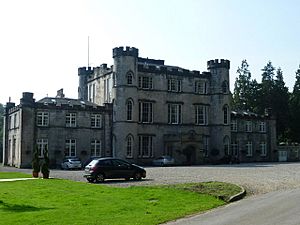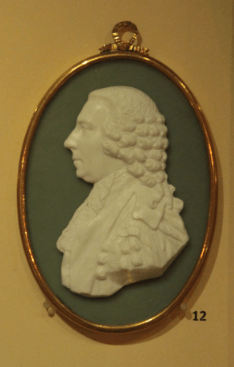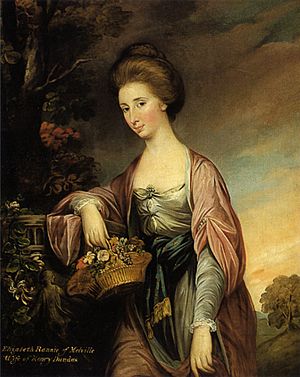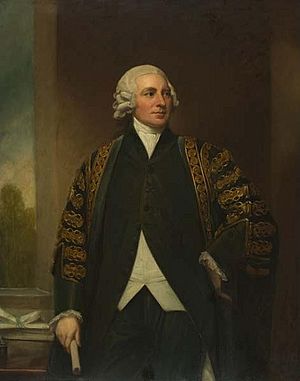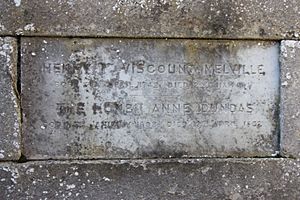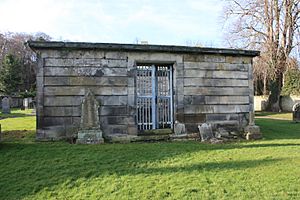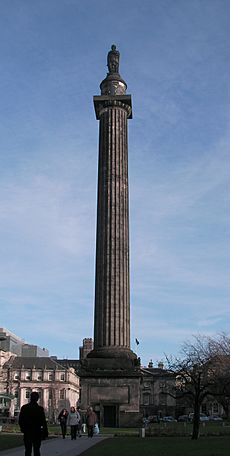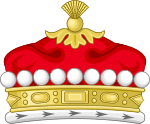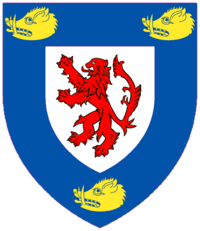Henry Dundas, 1st Viscount Melville facts for kids
Quick facts for kids
The Viscount Melville
PC FRSE
|
|
|---|---|

Henry Dundas, 1st Viscount Melville by Sir Thomas Lawrence
|
|
| First Lord of the Admiralty | |
| In office May 1804 – May 1805 |
|
| Monarch | George III |
| Prime Minister | William Pitt the Younger |
| Preceded by | The Earl of St. Vincent |
| Succeeded by | The Lord Barham |
| Secretary of State for War | |
| In office July 1794 – March 1801 |
|
| Monarch | George III |
| Prime Minister | William Pitt |
| Preceded by | New Office |
| Succeeded by | Lord Hobart |
| President of the Board of Control | |
| In office June 1793 – May 1801 |
|
| Monarch | George III |
| Prime Minister |
|
| Preceded by | The Lord Grenville |
| Succeeded by | Viscount Lewisham |
| Home Secretary | |
| In office 8 June 1791 – 11 July 1794 |
|
| Monarch | George III |
| Prime Minister | Pitt |
| Preceded by | The Lord Grenville |
| Succeeded by | The Duke of Portland |
| Lord Advocate | |
| In office 24 May 1775 – August 1783 |
|
| Monarch | George III |
| Prime Minister | |
| Preceded by | Sir James Montgomery |
| Succeeded by | Henry Erskine |
| Member of Parliament for Edinburgh |
|
| In office 1790–1802 |
|
| Preceded by | Sir Adam Fergusson |
| Succeeded by | Charles Hope |
| Personal details | |
| Born | 28 April 1742 Edinburgh, Scotland |
| Died | 28 May 1811 (aged 69) Edinburgh, Scotland |
| Nationality | |
| Political party | Independent Whig |
| Spouses |
|
| Children | Robert Dundas, 2nd Viscount Melville |
| Parents |
|
| Alma mater | University of Edinburgh |
Henry Dundas, 1st Viscount Melville (born April 28, 1742 – died May 28, 1811) was a very important Scottish politician. He was a close friend and helper to British Prime Minister William Pitt the Younger. Dundas was known as the most powerful politician in Scotland during the late 1700s.
He played a big part in encouraging the Scottish Enlightenment, which was a time of great learning and new ideas in Scotland. He also helped manage the war against France and expanded Britain's influence in India. Because of his strong influence in Scottish politics, people sometimes called him "King Harry the Ninth" or "The Uncrowned King of Scotland."
Contents
Early Life and Education in Scotland
Henry Dundas was born in Edinburgh, Scotland, on April 28, 1742. He was the fourth son of Robert Dundas of Arniston, who was a top judge.
He first went to Dalkeith Grammar School. After getting smallpox, he moved to the Royal High School in Edinburgh. Later, he studied law at the University of Edinburgh. While at university, he joined a debating society. This gave him his first chance to practice public speaking.
Dundas's Legal Career
Dundas became a lawyer in 1763 and quickly became well-known in the Scottish legal system. He became the Solicitor General for Scotland in 1766. In 1775, he was appointed Lord Advocate, which is a chief legal officer. After this, he focused more on public service than on his private law practice.
Fighting for Freedom in Court
In 1776, Dundas helped a man named Joseph Knight. Knight had been bought as a slave in Jamaica and brought to Scotland. He tried to escape and then went to court to gain his freedom. Dundas led Knight's legal team in a famous case called Knight v. Wedderburn.
Dundas argued that slavery should not exist in Scotland. He said that "human nature... spurns at the thought of slavery among any part of our species." He won the case, and the court decided that no one could be a slave on Scottish soil. This was a very important decision that helped many people gain their freedom in Scotland.
Dundas's Political Journey
Joining Parliament and Early Roles
In 1774, Henry Dundas was elected to Parliament for Midlothian. He was a proud Scottish speaker and quickly became known for his clear and strong speeches. In 1775, he became the Lord Advocate.
He held several important positions. In 1791, he joined the government as Secretary of State for the Home Department.
The Debate on Ending the Slave Trade
On April 2, 1792, William Wilberforce, a leader in the movement to end slavery, proposed that the slave trade should be stopped. Dundas agreed that the slave trade should be abolished. However, he believed it should happen gradually, not immediately. He thought that if Britain stopped the trade too quickly, other countries would just take over, and the trade would continue elsewhere.
Dundas suggested adding the word "gradual" to Wilberforce's motion. This change was approved by Parliament. This was the first time the House of Commons voted to end the slave trade. Dundas then proposed a plan to end the trade by the end of 1799. Parliament voted to end it by 1796. However, these plans did not get enough support in the House of Lords at the time.
The slave trade was finally abolished in the British Empire in 1807 with the Slave Trade Act 1807. Owning slaves, however, remained legal until 1833.
Different Views on Dundas's Actions
Historians have different opinions about whether Dundas's actions helped or delayed the end of the slave trade. Some historians believe his push for "gradual" abolition caused the trade to continue for longer. They argue that by linking abolition to colonial reforms, he created delays.
Other historians disagree. They point out that there were many challenges at the time, like wars with France and strong opposition in Parliament. They argue that an immediate end to the slave trade was unlikely to pass. By suggesting a gradual approach, Dundas helped ensure that Parliament voted for abolition at all, even if it took more time.
Important Government Roles
From 1793 to 1801, Dundas was the President of the Board of Control. In this role, he was in charge of overseeing the East India Company and British affairs in India. He was also a key advisor to Prime Minister Pitt during the Wars of the French Revolution.
He became the new Secretary of State for War in 1794. In this job, he organized several British military trips, including to the Caribbean. He tried to capture Saint-Domingue (now Haiti) from the French, but British forces faced many challenges and eventually withdrew.
Dundas also supported a strong British presence in the Mediterranean Sea. He played a key role in stopping Napoleon's attack on Egypt, which helped protect British interests in India.
Review of Financial Management
In 1802, a group called the Commissioners of Naval Inquiry began looking into how money was managed when Dundas was the Treasurer of the Navy (from 1782 to 1800). His paymaster, Alexander Trotter, admitted moving public money into a private bank account. While this did not cause a loss of public money, it meant that the interest earned on that money was lost.
Because of this, a formal review process was started against Dundas in 1806. This review took place in the House of Lords. Dundas was later found not guilty of any wrongdoing. He had already left the Privy Council in 1805 but rejoined it in 1807.
| Proceedings Against Viscount Melville Act 1805 | |
|---|---|
| Act of Parliament | |

|
|
| Long title | An Act to provide that the Proceedings now depending in the House of Commons upon Articles of Charge of High Crimes and Misdemanors which have been exhibited against Henry Lord Viscount Melville shall not be discontinued by any Prorogation or Dissolution of Parliament. |
| Citation | 45 Geo. 3 c 125 |
| Other legislation | |
| Repealed by | Statute Law Revision Act 1872 |
|
Status: Repealed
|
|
| An Act to indemnify Persons who shall give Evidence against Henry Lord Viscount Melville | |
|---|---|
| Act of Parliament | |

|
|
| Long title | An Act to indemnify Persons who shall give Evidence against Henry Lord Viscount Melville, upon the Impeachment voted against him by the Commons of the United Kingdom of Great Britain and Ireland in Parliament assembled, in respect of Acts done by such Persons in any Office or Employment held by them under the said Lord Viscount Melville, during the Time he held and enjoyed the Office of Treasurer of His Majesty's Navy. |
| Citation | 45 Geo. 3 c 126 |
| Other legislation | |
| Repealed by | Statute Law Revision Act 1872 |
|
Status: Repealed
|
|
Dundas's Family Life
Henry Dundas first married Elizabeth Rannie in 1765. They had four children together. Their marriage ended in divorce in 1778. Henry Dundas kept their home, Melville Castle, and raised their children there. He continued to support Elizabeth financially until his death.
In 1793, Dundas married Lady Jane Hope. He passed away in May 1811 in Edinburgh, at the age of 69. His son, Robert, inherited his titles. Henry Dundas is buried in a family vault in Old Lasswade Kirkyard, Scotland.
Legacy and Memory
After his death, Henry Dundas was widely praised. However, by the early 1900s, some historians criticized him. Later, in the late 20th century, his reputation improved again. He is now recognized for his military policies, for helping to create a strong government in Scotland, and for Scotland's role in the British Empire.
Many places around the world are named after Henry Dundas:
- The town of Dundas in Canada was named after him by John Graves Simcoe, a governor.
- Several streets and highways in Canada, like Dundas Street in Toronto, are also named after him.
- Dundas County, Ontario was named in his honor in 1792.
- Dundas Island in British Columbia was named by Captain George Vancouver. Other nearby islands were named Melville Island, Baron Island, and Dunira Island, reflecting his titles.
- The District of Dundas in New South Wales, Australia, was named after him.
- In Western Australia, the Dundas Hills and the Shire of Dundas are named after him.
- A large monument, similar to a tall column, stands in St Andrew Square, Edinburgh, Scotland. It was built in 1821 and has a statue of Dundas on top. The Royal Bank of Scotland headquarters nearby is called Dundas House.
- A statue of Dundas is inside Parliament Hall in Edinburgh.
- The Melville Monument, an obelisk, stands on Dunmore hill in Comrie, Perthshire.
- Dundas Street, Hong Kong, is also named for him.
Arms
|


